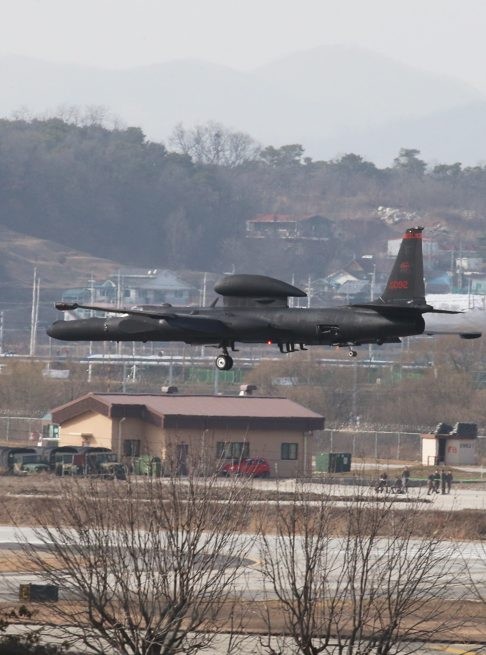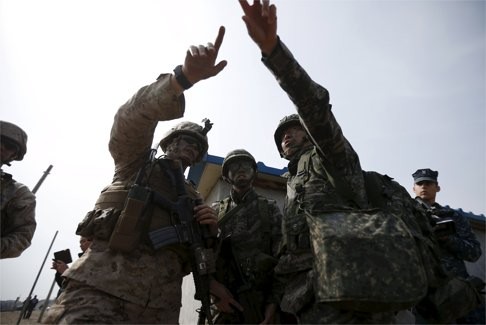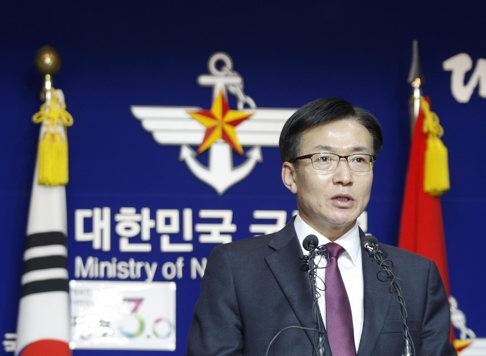
North Korea threatens to turn US and the South into ‘flames and ashes’ with nuclear strikes as largest ever drills begin
North Korea threatened “indiscriminate” nuclear strikes against South Korea and the US mainland, as the two allies began large-scale joint military drills on Monday.
The threat to carry out what it described as a “pre-emptive nuclear strike of justice” was made in a statement by the North’s powerful National Defence Commission, citing the Supreme Command of the Korean People’s Army.
It came just days after leader Kim Jong-un ordered the country’s nuclear arsenal to be placed on standby for use “at any moment”, in response to tough new UN sanctions imposed over the North’s fourth nuclear test in January and last month’s long-range rocket launch.
READ MORE: Don’t pass the buck on North Korea’s nuclear programme, China tells United States
Pyongyang has issued dire warnings of nuclear attack in the past, usually during periods of elevated military tensions on the divided Korean peninsula.
While the North is known to have a small stockpile of nuclear warheads, experts are divided about its ability to mount them on a working missile delivery system.
The National Defence Commission described the annual South Korea-US military exercises as “undisguised nuclear war drills” that threatened the North’s national sovereignty, and vowed an all-out offensive in response to “even the slightest military action”.

Under a military plan ratified by the North Korean leadership, any strike would not just target operational theatres on the Korean peninsula, but also US bases on the mainland and in the rest of the Asia-Pacific region.
“If we push the buttons to annihilate the enemies even right now, all bases of provocations will be reduced to seas in flames and ashes in a moment,” it added.
Despite a pair of successful long-range rocket launches, North Korea is largely believed to be years away from developing a genuine intercontinental ballistic missile capable of reaching the US mainland.

This year’s drills are called Key Resolve and Foal Eagle.
Details of the drills have not been disclosed, but South Korean Defence Minister Han Min-koo said last month the exercises would be the largest ever in terms of troop size and military assets.
Han said the exercises will involve about 17,000 US troops, twice the average number in previous years, and about 290,000 South Korean troops, about one and a half times more than previous years.
Han said that among the US military assets to be mobilised are a combat aviation brigade, maritime police mobile unit and carrier strike group.

Media reports said South Korean and U.S. troops plan to implement in this year’s Key Resolve exercise their new military operation plan, OPLAN 5015, which aims to remove North Korea’s possible use of weapons of mass destruction and prepare for a pre-emptive attack in the event of a North Korean attack.
In addition, a Ssangyong amphibious exercise started on Monday and will run until March 18. It involves about 3,000 South Korean Marines and 7,000 US Marines, according to local media reports.
The South Korean Defense Ministry brushed off the North’s threats, saying the joint exercises have been held annually and are entirely defensive in nature.

“If North Korea makes further reckless provocations, it will be held accountable for all consequences arising from them,” Moon said.
Pyongyang has long condemned the drills as provocative rehearsals for invasion, while Seoul and Washington insist they are purely defensive in nature.
China also opposes the exercises. Chinese Foreign Ministry spokesman Hong Lei said that Beijing was “deeply concerned” and warned against “troublemaking”.
“China is linked to the Korean Peninsula. In terms of the peninsula’s security, China is deeply concerned and firmly opposed to any troublemaking behaviour on the peninsula’s doorstep. We urge all sides to keep calm, exercise restraint and not escalate tensions,” he told a daily news briefing.
Tensions have surged on the Korean peninsula since the North’s nuclear test on January 6 and February’s rocket launch, which was seen as a disguised missile test.
A UN Security Council resolution adopted last week laid out the toughest sanctions imposed on Pyongyang to date over its nuclear weapons programme and will, if implemented effectively, apply significant economic pressure on Kim’s regime.
READ MORE: Obama green lights new sanctions against North Korea over nuclear programme
It breaks new ground by targeting specific sectors key to the North Korean economy and seeking to undermine the North’s use of, and access to, international transport systems.
Pyongyang has rejected the sanctions as “unfair, illicit and immoral” and vowed to keep building its nuclear arsenal.
The National Defence Commission said the US and its allies had failed to realise how the “outrageous” sanctions made “this land boil like a crucible of battle”.
Additional reporting by Kyodo and Reuters

.png?itok=arIb17P0)